
Arthur Emil Edwin Von Frankenberg (1887/9 - 1950)
Arthur Frankenberg was an artist who was particularly active in the 1920s.
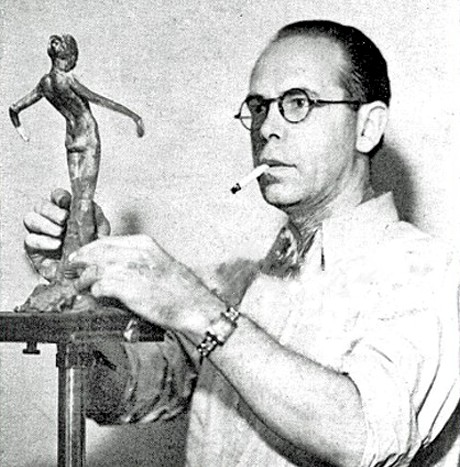
Arther Frankeberg Sculpting a Statue, Decollector
As with many of the lesser known artists from this period, there is conflicting information about him. According to one source, he was born in Milwaukee in 1887, although other sources indicate the year of his birth as 1889 without specifying where he was born. His grandfather Emil had immigrated to the US from Germany around 1845. "Arthur had started out as an accountant, but in his early 20s studied art in Washington, where his father Hermann was based as a travelling salesman. In 1912 Arthur married Ruth Crawford, from Illinois, and shortly after they moved to New York. There Arthur became a full-time artist". (Marcus P., Just Answer Website, gathered 1-6-25)
His sculpturing of what were eventually known as Frankart sculptures is explained in the following story (which may be apocryphal).
The story goes that one day, while painting and entertaining some friends at the same time in his new art-filled studio, one of his visitors looked around for a place to dispose of his cigar ashes and found none. Leone [Osborne, a model], who was posing for the current work at hand, realized the man's concern and jumped up from the divan and picked up a large Benares brass bowl, which was a full three feet across and had been sitting on a taboret. She struck an eccentric pose and offered it to the visitor for his ashes. Everyone laughed at the new five foot six inch ashstand!" (Leon Edward Joseph, "Who's That Girl?" From Arts & Models Magazine (1926), David's Deco website, gathered 1-6-25 - The linked to page contains an image of Leone Osborne posed in the described position.)
The whole affair gave Frankenberg the idea to sculpt a small bronze ashtray in the same pose. This was likely in the late 1910s or possibly 1920. He was so taken with the notion, that he stopped his other work and and began designing what would become the first Frankart figure. (See the image.) An article found on the Art Deco Society of
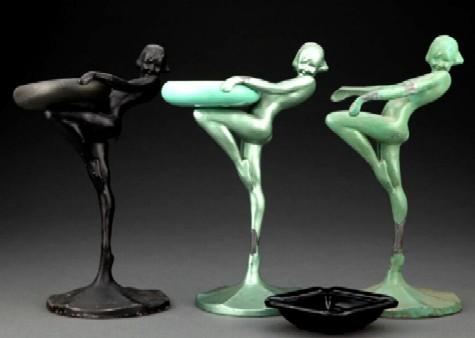
Girl Holding an Ashtray Sculptures, Enameled Metal, 1922, Artnet
New York's website states that the first deco girl ashtrays were produced for sale in 1921. (Robert Salamone, "Frankart Revisited: The Fantasy Females of Frankart Incorporated", Art Deco Society of New York website, gathered 1-6-25) Osborne apparently continued to be von Frankenberg's model for the dozens of various female sculptured items which followed.
According to Frankenberg's future business partner Henry Underberg, von Frankenberg approached him about retailing one of his figures while he was working of Old World Arts, Inc. (formerly The Metal Export Company of America) in New York. As Underberg tells it,
One day a gentleman, a young man, came in and showed me a metal figurine and wondered if I would show it in the shop and sell it on consignment. I looked at the figurine and was very much impressed by its beauty. The gentleman was Arthur Frankenberg, a sculptor. I took a few of the figurines and they sold well. I took more and more. After a little while I had had enough of that shop and I decided to go into business for myself." (Henry Underberg, "A Little History of Frankart, Inc.", David's Deco website, gathered 1-6-25)
Underberg doesn't mention when the described meeting occurred although it was likely around 1920-2. He may not have been certain since the account appears to have been given long after it happened. Underberg established the Hennart Company. Working with local foundry owner George Murad, Hennart used Murad's shop to cast their pieces. At some point early in the nascent company's history, Frankenberg approached Underberg about selling his statues. Underberg introduced him to Murad who helped Frankenberg to mass produce his designs.
In 1922, Frankenberg, Underberg and Murad
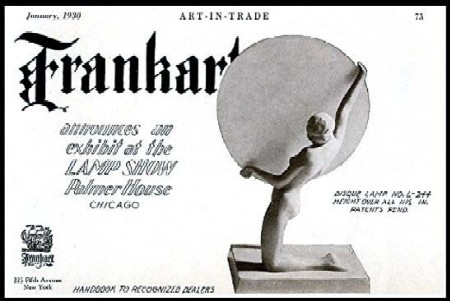
Advertisement from Art-in-Trade with Frankart Disc Lamp, 1930, Decocollector
(now the factory manager for Underberg) formed Frankart to produce and market Frankenberg's products. Underberg notes the he came up with the Frankart name. "Frankenberg was the president, I was the Vice-President and General Manager and George Murad was the Secretary." (Underberg, "A Little History... ) The company was formally incorporated in 1924 as Frankart, Inc. Their partnership was established so that Frankenberg owned 3/5 of the company with the profits divided equally between the three partners.
Frankart was quite successful from the beginning with designs which included golfers, animals, cowgirls and his nudes. It was the latter which sold best. "The early catalog from the 1920's offered less than 30 items, including four lamps, five candlesticks, and five ash-trays; other items included bookends, incense burners, flower holders, ink wells and centerpieces. By the 1930-31 season, the Frankart line had dramatically expanded. The handbook for that season offered over 45 lamps, 18 ashtrays, 13 bookends, as well a broad variety of items that included smokers stands and smokers sets, an aquarium, clocks, wall plaques, flower vases, and cigarette holders." (James Champion, "Decocollector - Frankart Inc.", Decocollector website, gathered 1-6-25)
On April 29, 1925, Frankenberg sailed for Europe where he visited England, France, Germany and Italy. The goal of the trip was to "devote
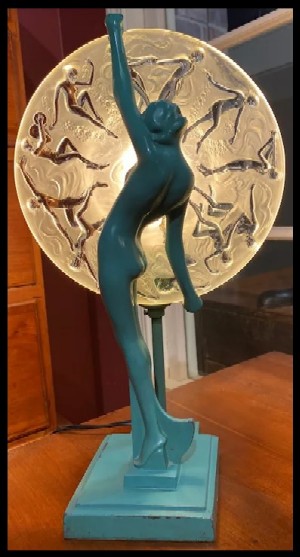
Nymph Lamp with Lalique-Style Glass Shade,
Frankart,
1920s, Ruby Lane
considerable time to the study of modern works of art and foreign methods of manufacture in metal lines. Any new ideas he may bring back with him will find expression in the artistic creations he is constantly designing." (Giftwares, May, 1925, p. 68) It seems likely that he would have visited the touchstone Exposition Internationale des Arts Décoratifs et Industriels Modernes in Paris which happened to begin the day before he sailed and continued through the end of October, 1925.
By 1928, sales had expanded to the point that the company moved to "more commodious" offices. As a press release explains, "the substantial increase in business caused by the growing popularity of the line, and the addition of many new numbers, this expansions has been made mandatory." (Lamp Buyer's Journal, September, 1928, p. 33) The article also notes that the company would nr displaying their wares at shows in Chicago, Philadelphia and Boston that year. During the company's tenure, it sold through a variety of distributors, although they changed over time. Among the distribution locations found in their literature over the years were Los Angeles, New York, Chicago, Portland, Oregon, Toronto, Canada, London, Mexico, Argentina and Australia.
Frankenberg eventually became disenchanted with the profit sharing agreement. In a letter to Underberg dated December 23, 1930, he wrote,
Frankart, Inc. depends upon me for the designs of the articles for which it sells. I own three-fifths of the capital stock and yet am limited to one-third of the profits of the business which spring entirely from my creative work notwithstanding that under the laws of this state I am, as the principal stockholder, entitled to dividends upon my stockholding. I have been advised that there is some doubt as to the validity of the [original] agreement. (David Negly, "The Beginning of a Lawsuit - The End of a Partnership", David's Deco website, gathered 1-6-25)
He threatened to take his molds and begin producing products independently of Underberg and Murad if they didn't agree to renegotiate the profit sharing agreement. This led to a lawsuit which Frankenberg lost. He took some of his designs, likely those that the company hadn't patented, and founded Quoizel Metal Art Company. He filed a number of patents for his artwork in mid-1931, but these designs weren't sufficient to keep the company going and it ceased operations the same year.
At Frankart, Underberg sold the rights to the name 'Frankart' to Murad, who continued making figures. With Frankenberg out, designs were provided by Underberg and artists Helene Cross and Max Abel. Frankart continued to sell giftware until 1935, when it also ceased operations. Some commenters suggest the problem with
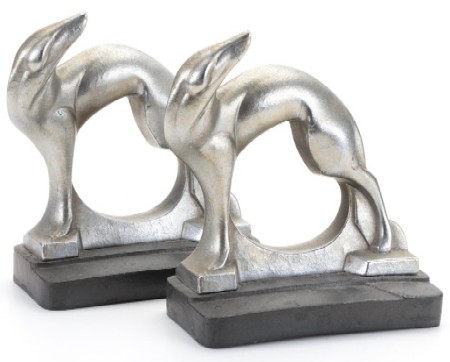
Greyhound Bookends, Probably Silver Enamel Over Spelter, Frankart, 1920s,
Everything but the House
these two companies was a lack of original new products, but it seems much more likely that the belt tightening brought on by the Depression was the likely culprit. 'Giftware' just wasn't a priority to a Depression-shocked public.
It is not clear what happened to Frankenberg after 1931. Underberg reported, "A few years after we separated from Frankenberg, he came into the showroom one day and showed me a little statuette of Winston Churchill. But before he did that, he wanted to tell me how sorry he was. I didn't have much to say about that and our conversation was on the rather cool side. That was the last time I saw Frankenberg." (Underberg, "A Little History... ) From this, it appears Frankenberg had returned to sculpting, likely operating as an artist. Most of the original Frankart molds were found in storage in the 1940s, but the taste for such items had dissipated and they were sold to a scrap metal firm which melted them down, possibly for the war effort. (Salamone, "Frankart Revisited...")
The popularity of Frankenberg's designs has endured among some collectors. Beginning in the 1970s, some of his designs were reproduced, apparently from the original sculptures since the molds had all been destroyed.
The style of Frankenberg's statues is notable. Robert Salamone cites an early company catalog
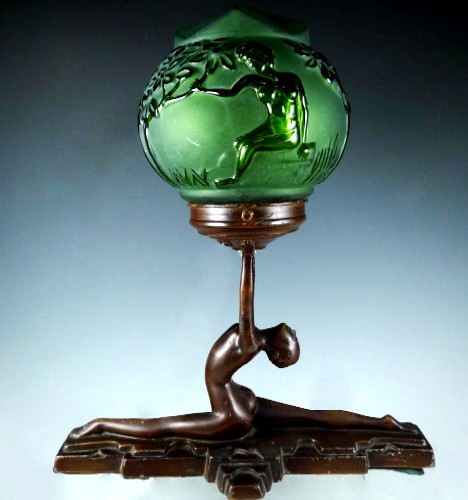
Lamp, Painted White Lead and Glass, Frankart, 1920s-30s, Mark Lawson Antique
which describes it. "Particular emphasis has been stressed on artistic conceptions of streamline designs expressing the modern vogue. Inventive ingenuity has been happily combined with artistic ability to create objets d'art of practicability." This streamlining is evident in even his earliest pieces dating from 1921, prefiguring the Streamline Moderne design explosion of the 1930s. Salamone explains, "Von Frankenberg's smooth lines and his subtle hints at detail show his personal reaction to the European treatment of metal figures. By his elimination of their often overly elaborate costumes, and intricately worked heads and hairstyles, we are left with clean-cut, modernistic figures, perhaps inspired by Cubist painters or by the new purist philosophy of design." ("Frankart Revisited...")
Although trademarked, his designs were widely copied with minor changes to escape prosecution during the height of their popularity. Over time, other notable artists began creating streamlined statues, with a variety of them found in the mid-late 1920s and 1930s. It is not clear that Frankenberg was the inspiration for these artists, but the similarities are undeniable. As the first image below suggests, the statues came in a variety of colors which included "Japanese Bronze (very dark brown, almost black with green in the crevices), and Verde (Roman Green) finishes were offered. Other colors added to the line include Bronze (copper-like tone), Gunmetal (dark gray), Paine (fine green), Pearl Green (pale iridescent), Pearly Ivory (white iridescent), Red (flat Chinese red), and Verde Antique (dark green with black overtones).
Source Not Mentioned Above:
Harry L, Rinker, "Rinker on Collectibles — Column #1307", Harry Rinker website, gathered 1-6-25)
Original Facebook Group Profile
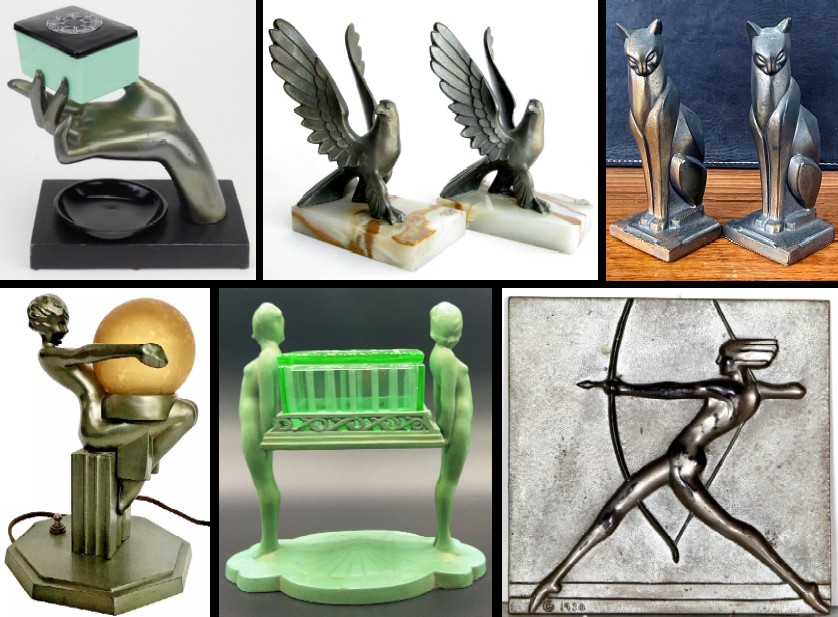
Frankenberg Sculptures, from left - Frankart, Smoker's Set with Cigarette Box and Ashtray, Spelter and Glass, 1930, Artnet; Eagle Bookends, Not Frankart, but by Frankenberg, 1930, Edgebrook House; Cat Bookends, Bronze over Spelter Metal, Frankart, 1930s, 1st Dibs; Pixie Lamp, Frankart, Enamel over Spelter and Glass, 1920s, Ebay; Nudes Carrying Uranium Glass Cigarette Box, Frankart, CTBids; Frankenberg, Plaque with Archer, Metal, 1930, Invaluable